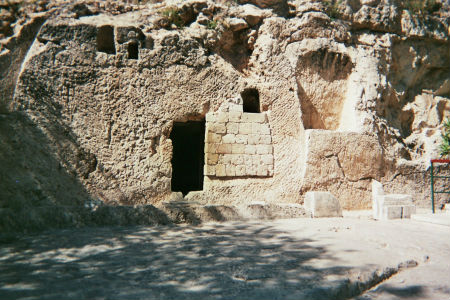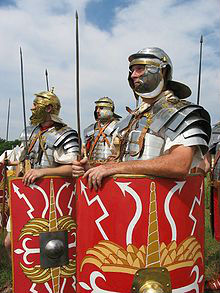The Romans, the Resurrection and Reality
 Though not the site of Jesus' burial it visually recalls the events of his entombment and resurrection.
Though not the site of Jesus' burial it visually recalls the events of his entombment and resurrection.The Romans!
We all heard of them at school.
They left a long shadow – the U.S. lawmakers who are named “Senators,” two famous NHL hockey rinks called the Forum, the Capitol dome in D.C. Legal terms such as “habeas corpus” or “posse comitatus.”
Hollywood can’t get enough of them even when the Bible is involved. Epic movies such as “The Robe” (1953) and “Ben Hur” (1959) show that – flawed but nevertheless important attempts to capture the power and might and reach of the Roman Empire for modern audiences.
One thing is certain and one thing is for sure for lovers of the Bible: Once Jesus was in the hands of the all-powerful no-nonsense Romans he would not escape them by trickery or collusion.
The “Theft” Theory
And 2000 years later that is important. It is important because people today concoct or invent all kind of excuses as to why the Bible account of Jesus’ resurrection is a fiction. One of the most popular is the Theft Theory, i.e. that the disciples crept in to steal the body of Jesus after his crucifixion.
But NO. That just did not happen.
 A Centurion: The most highly respected rank in the army and one became firm witness to Jesus' death.
A Centurion: The most highly respected rank in the army and one became firm witness to Jesus' death.The Romans and the Jewish leaders together unwittingly created the best answer against that possibility.
Matthew’s Gospel reveals how the crafty first century leaders of Judaea foresaw that “theft” possibility and went to the Roman governor Pontius Pilate about it the day after Jesus’ death.
“‘Sir,’ they said, ‘we remember that while he was still alive that deceiver said, ‘After three days I will rise again.’ So give the order for the tomb to be secure until the third day. Otherwise his disciples may come and steal the body and tell the people that he has been raised from the dead’…’Take a guard.’ Pilate answered, “Go, make the tomb as secure as you know how.’ So they went and made the tomb secure by putting a seal on the stone and posting the guard” (Matthew 27:63-66).
We know from history what was on that seal. It was the word SPQR – “Senatus Populusque Romanus,” meaning “The Senate and the People of Rome.” Woe betide the person who broke a Roman seal – you’d be dead if captured. And the guard was there to deter any attempt at stealing the body from outside.
Could the disciples have pulled it off, engineered the greatest hoax in history, absconding with the body of Jesus and pretending he had been raised? With the Roman guard on the job? This is highly unlikely to the nth degree.
The writer Albert Roper made this point: “Soldiers cold-blooded enough to gamble over a dying victim’s cloak are not the kind to be hoodwinked by timid Galileans or to jeopardize their Roman necks by sleeping on their post.”
 Nerve center of a very well-run empire – the Gospel is launched in a very literate age.
Nerve center of a very well-run empire – the Gospel is launched in a very literate age.The Evidence Unfolds
Excellent argument. No one got into the tomb, the Romans and the Jews had made that possibility fool-proof. It is highly unlikely that scared fishermen, emotionally devastated women and humble tax collectors would make such a claim unless…something like the Bible account took place.
What did happen?
“After the Sabbath, at dawn on the first day of the week, Mary Magdalene and the other Mary went to look at the tomb. There was a violent earthquake, for an angel of the Lord came down from heaven and, going to the tomb, rolled back the stone and sat on it…The guards were so afraid of him that they shook and became like dead men…some of the guards went into the city and reported to the chief priest everything that had happened (Matthew 28:1-11).
Why did the guards report to the Jewish leadership?
Instead, the Jewish leaders paid them off and told them to spread the word that the disciples had stolen the body. But that, as we have been saying, reaches the outer limits of possibility by their own deeds of sealing and securing and guarding the tomb.
The Gospel writers show that the Romans, by their impeccable ability to control events unwittingly constructed one of the best cases ever for the resurrection of Jesus Christ.
The Unseen Hand
Yes, Jesus was raised and is alive forevermore. But what does that mean for us, for us and the whole world? Three things. Here they are.
First, Jesus’ resurrection by the power of the Father and the Spirit validated for all time that he was who he said he was. Romans 1: 4 says it was “through the Spirit of holiness (Jesus) was appointed the Son of God in power by his resurrection from the dead.” The documents that establish the resurrection of Jesus are the title deeds of the Christian faith. It showed Jesus was going to keep his promises to us – “He who lives and believes in me shall never die…because I live you shall live also” (John 14:19).
 Plaque found in Caeserea in 1961 lists two Roman officials almost identical to wording in Luke 3:1-2.
Plaque found in Caeserea in 1961 lists two Roman officials almost identical to wording in Luke 3:1-2.Secondly, the fact of Jesus’ resurrection broke the power of sin and death. At his death Jesus took upon himself the sins of the world and cancelled them out. But by his new life, resurrected life, life in a glorified spiritual body, he imparts the gift of life to all of us at baptism. This is why St. Paul said that we were reconciled to God by the death of his son but “we shall be saved by his life” (Romans 5:9-10).
The great Victorian preacher Charles Spurgeon taught: “The gospel did not come into this world merely to restrain the passions or educate the principles of men, but to infuse into them a new life which, as fallen men, they did not possess.” The life we have now is mere temporary, chemical existence. But the new life Jesus gives us is eternal life which is why we sing the song, “If anyone is in Christ, then he is a new creation, the old has passed away, and all things are made new” (2 Corinthians 5:17).
What a hope! What a God we serve!
Third, the resurrection of Jesus truly tuned the world upside down. Those cowering disciples came streaming out of Jerusalem in the first century with the best news human ears could ever hear; amnesty is proclaimed to sinners, the world is run on a different principle than before, the pierced hand has triumphed over the mailed fist!
And all around this world people are entering prisons, delivering food, relieving suffering in the name of the Living Jesus Christ. After the events of Calvary, the ends of the earth are told to look to God and his Son for salvation, for rescue and healing. This means the Gospel truly is Good news for all who embrace it. We pray that you are one of them.
The Roman File
Roman justice could be cruel. After the Spartacus rebellion in 71 BC, they crucified 6000 victims on crosses along the road to Rome. But strangely, every time a Roman centurion is mentioned in the New Testament it is in a favorable light. St. Paul even uses the Roman armor as a model for fighting the Christian fight in Ephesians 6.
 Those Romans assigned to guard the tomb of Jesus were too professional to allow any tampering with his body.
Those Romans assigned to guard the tomb of Jesus were too professional to allow any tampering with his body.There is more:
– The Romans start the action moving when Augustus Caesar decrees that the whole world will be taxed. This sets Joseph and Mary on the road to Bethlehem (Luke 2:1-4).
– In the Sermon on the Mount Jesus tells his disciples to go two miles if compelled to go one. Carrying a piece of baggage was a common Roman practice inflicted on the common people (Matthew 5:41).
– One centurion staggered Jesus with his faith reply in a request for healing: “Just speak the word, Lord, and that will be enough (Luke 7:1-10).
– The first public testimony to Jesus’ divinity by another human being comes from the Roman officer in charge of the crucifixion: “Surely this man was the Son of God” (Mark 15:39).
– The Romans guard the tomb of Jesus and become “witnesses-in-reverse” that something strange had happened that first Easter.
– Cornelius, a Roman officer, becomes the first Gentile to be converted (Acts 10).
– Julius, the Centurion assigned to escort Paul to his trial in Rome, treats Paul kindly and soon learns he has a very special prisoner on his hand (Acts 27:1-3; 27:43).
– Later, Paul wins converts in the very “household” of the emperor, probably among his staff (Philippians 4:22).
In Revelation Rome will become the city on the seven hills and a persecutor of the church but before that, the New Testament writers are fair to the Romans as they were often fair to the church (Acts 17:12-16). There is even a major book called “Romans.” There is no doubt: The Roman presence across the New Testament helps lend credence and weight to the veracity of the Gospel story.